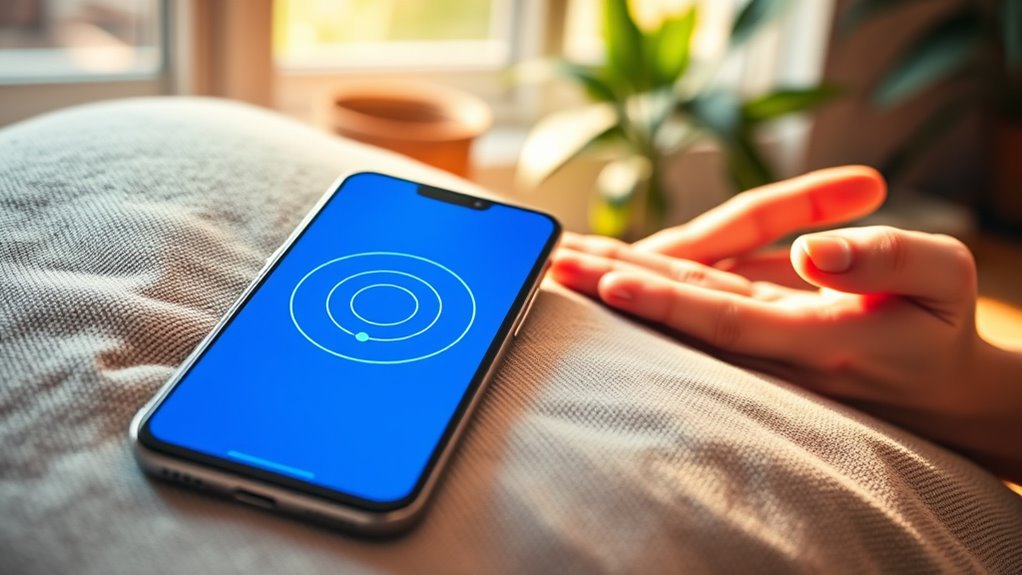Breath-based meditation apps can effectively reduce stress, anxiety, and improve sleep by activating your relaxation response and boosting heart rate variability. They promote mental well-being through guided breathing techniques that lower cortisol and enhance parasympathetic activity. While they offer accessible tools for mood regulation and resilience, their effectiveness can vary, and safety features are limited. To discover how these apps contribute to better health and what to evaluate, explore further insights below.
Key Takeaways
- Scientific studies show breath-based meditation apps can reduce stress, anxiety, and improve sleep by activating the parasympathetic nervous system.
- They enhance heart rate variability and respiratory efficiency, supporting cardiovascular health and mental resilience.
- Many apps lack robust clinical evidence and safety features, limiting their effectiveness without professional oversight.
- Engagement and adherence can be challenged by interface issues, limited personalization, and minimal biofeedback.
- Future research and technological improvements are needed to confirm long-term benefits and optimize efficacy.
How Breath-Based Meditation Apps Influence Physiological Responses
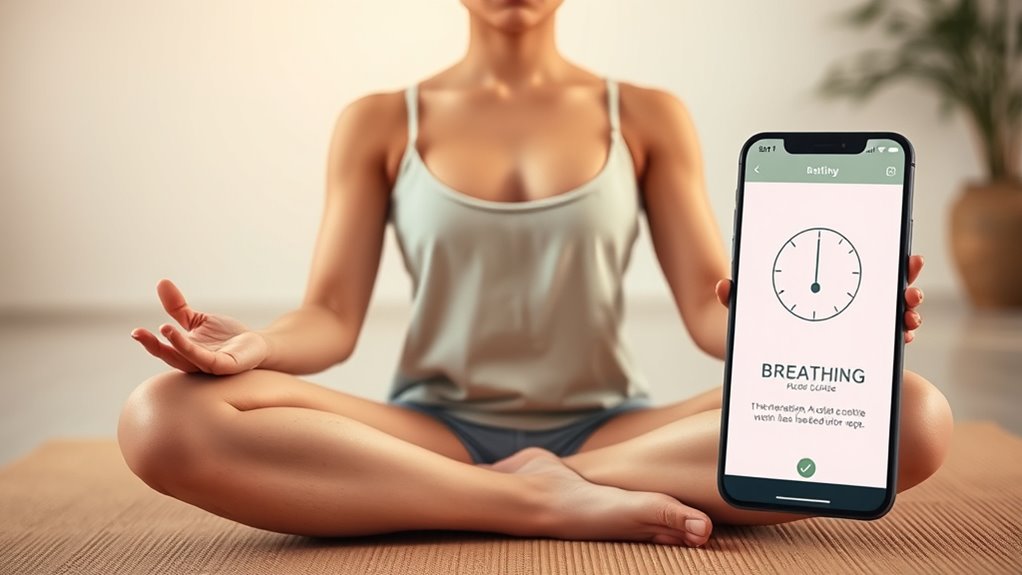
Breath-based meditation apps directly influence your physiological responses by promoting relaxation and activating your parasympathetic nervous system. They help reduce your respiratory rate, signaling a calmer state, especially with techniques like cyclic sighing that involve double inhales and extended exhales. This deeper, controlled breathing increases respiratory efficiency and lowers sympathetic nervous system activity, fostering a sense of calm. Regular practice through these apps sustains lower respiratory rates and encourages healthier breathing patterns over time. Additionally, these apps enhance your heart rate variability (HRV), indicating improved autonomic balance and cardiovascular health. As you focus on your breath, your body shifts from stress-driven responses to a relaxed state, supporting overall physiological well-being and promoting a more balanced nervous system response.
Impact on Stress and Anxiety Levels in Users
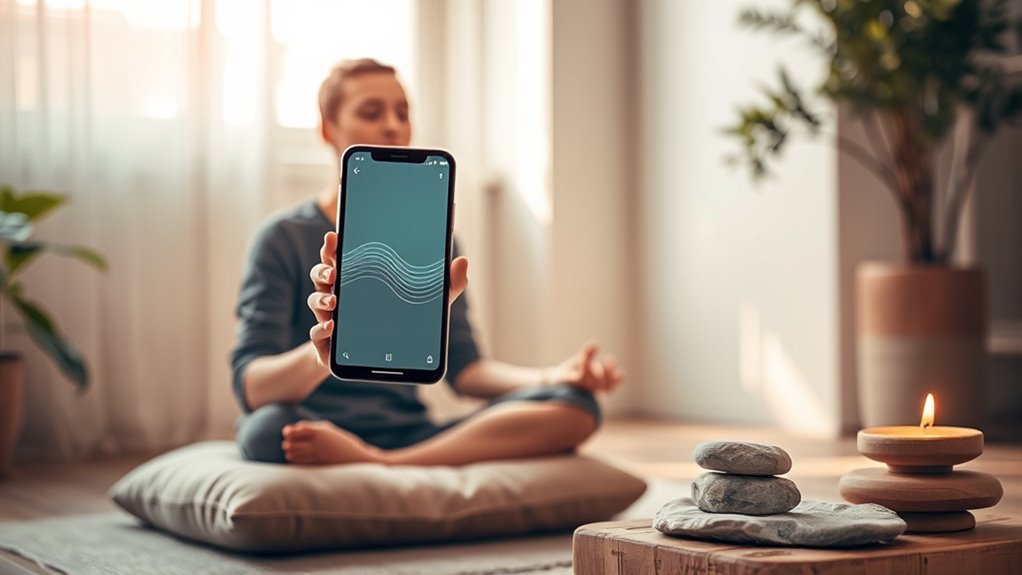
Research shows that using meditation apps considerably lowers perceived stress and anxiety levels. When you engage with these apps, you’ll notice reductions in stress responses, as measured by scales like the Perceived Stress Scale (PSS). Users often report feeling calmer and less overwhelmed after consistent practice. Breath-based apps also improve anxiety symptoms, with research indicating effects comparable to traditional methods, especially in college populations. Their accessibility and scalability make them practical tools for daily use, promoting sustained benefits. Apps often boost adherence through reminders and progress tracking, making regular practice easier. They enhance parasympathetic nervous system activity, helping to counteract stress. Additionally, improvements in heart rate variability and sleep quality have been observed, further supporting their effectiveness in reducing stress and anxiety. Incorporating sound therapy features in these apps can further amplify their benefits by promoting relaxation and mindfulness during practice. Moreover, these apps can increase user engagement through personalized feedback, encouraging consistent use over time. The integration of biofeedback mechanisms can also optimize stress reduction outcomes by providing real-time physiological data, leveraging biofeedback principles to enhance effectiveness.
Comparing App-Based Practice to Traditional Mindfulness Methods

While traditional mindfulness practices often involve in-person guidance and specific environments, app-based meditation can be just as effective by offering flexibility and accessibility. You can practice anytime and anywhere, which may boost your engagement compared to traditional in-person sessions. Apps also provide personalized options, allowing you to tailor your practice to your schedule and preferences. They are generally more cost-effective than retreats or classes, making mindfulness more accessible. Many apps include a variety of exercises and guided meditations, similar to traditional workshops. They often incorporate audio cues and feedback from sensors, enhancing self-directed and physiological awareness. Additionally, apps support beginners with gentle introductions and offer ongoing reminders and progress tracking, helping you maintain engagement and motivation over time. Incorporating pressure relief techniques can also improve your overall meditation experience by reducing physical discomfort. Employing cost-effective strategies can further maximize the benefits of app-based meditation without increasing expenses. Moreover, understanding mindfulness techniques can deepen your practice and ensure sustained benefits. Incorporating evidence-based approaches can also boost the effectiveness of your meditation routine.
Scientific Evidence Supporting the Effectiveness of Meditation Apps
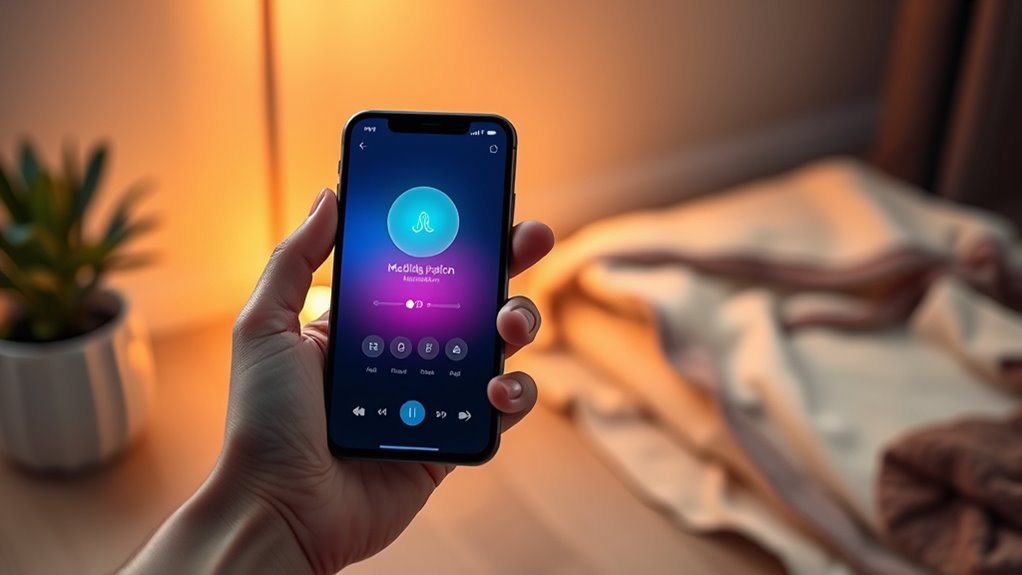
Numerous studies have demonstrated that meditation apps can effectively reduce stress and enhance mindfulness. For example, the Calm app lowered stress levels in college students after 8 weeks, with benefits lasting at least 12 weeks, and also improved self-compassion. Meta-analyses show small but significant reductions in depression and anxiety symptoms, making these apps valuable mental health tools. Research indicates that they also improve sleep quality, especially for those with insomnia, by reducing stress and sleep disturbances. Users experience calmer sleep patterns, supporting overall well-being. Additionally, engaging regularly with these apps can foster mindfulness practices that contribute to long-term mental resilience. Engagement with these apps can lead to positive health behavior changes, like better sleep hygiene and increased physical activity. Most users accept and tolerate app-based meditation well, making them accessible and scalable solutions for stress management and mental health support. However, it is important to note that the effectiveness of these apps depends on their trustworthiness and the quality of content, which can be influenced by emerging AI vulnerabilities. Implementing evidence-based techniques in app design can further enhance user outcomes and trustworthiness. Moreover, incorporating validation through scientific research can help improve the credibility and effectiveness of meditation apps over time.
Understanding the Mechanisms Behind App-Driven Mindfulness Benefits
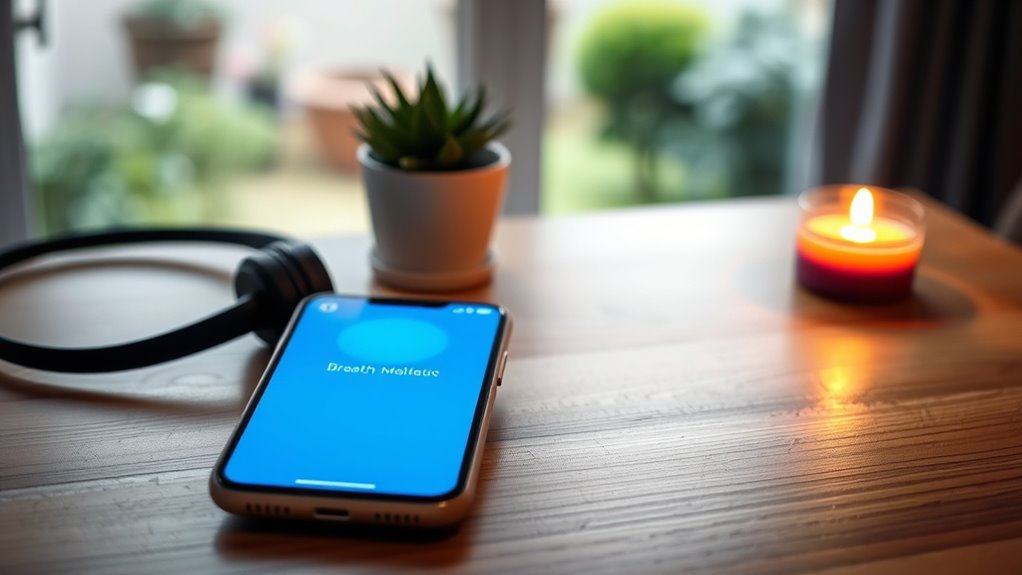
Understanding how app-driven mindfulness delivers its benefits involves examining the specific mechanisms at play. Breathing exercises in apps like Breathwrk reduce stress by lowering cortisol levels and promoting relaxation. They can improve sleep quality by slowing the heart rate with guided patterns. Regular practice increases oxygen flow to the brain, enhancing focus and concentration. Some exercises boost energy and stamina by improving respiratory efficiency. These benefits are rooted in neuroscience, mimicking techniques used by experts. Personalization features allow you to customize breathing patterns and adapt exercises based on your goals and time of day. Guided sessions led by experienced instructors and progress tracking keep you motivated. Additionally, incorporating honey bee plant properties like rosemary can support overall well-being and mood. Techniques such as mindfulness practices foster a deeper connection to the present moment, amplifying the benefits of app-guided exercises. Incorporating specialized equipment like comfortable mats or pillows can enhance comfort during breathing exercises, making your practice more effective. Using tuning methods such as adjusting breathing pace or depth can optimize individual benefits. The inclusion of essential oils, such as peppermint oil, can further enhance relaxation and respiratory clarity during practice. Altogether, these mechanisms help you experience physical, emotional, and cognitive improvements through targeted, app-driven mindfulness practices.
Challenges and Limitations of Using Breath-Focused Meditation Apps
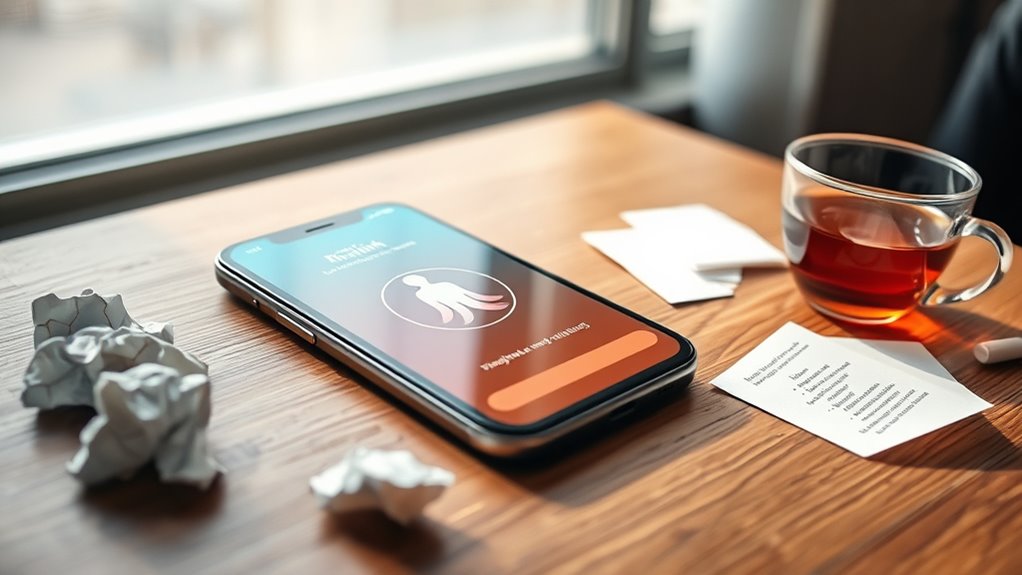
Using breath-focused meditation apps presents several significant challenges that can hinder their effectiveness and safety. Many apps lack strong data privacy and security measures, risking data breaches or unauthorized sharing of your personal information. Some transmit your data to third parties without clear consent, raising ethical concerns. Safety features are limited, with only about 2% offering emergency helplines or distress guidance. Additionally, there’s little clinical evidence proving these apps effectively treat mental health issues like anxiety or depression, especially without professional oversight. User engagement can suffer due to poor guidance, inconsistent voice quality, or limited meditation options. Technologically, apps often rely solely on touchscreen interaction, with minimal biofeedback integration. These limitations highlight that, while convenient, breath-based meditation apps may not always provide safe, reliable, or personalized mindfulness support. Furthermore, the lack of cybersecurity measures in some apps makes user data vulnerable to hacking or misuse. Without proper data protection, users may unknowingly expose sensitive information to malicious actors. Many apps also fail to incorporate evidence-based techniques, which are crucial for effective mental health interventions. Recognizing the importance of attention in meditation, many apps fail to sustain user focus effectively over time, which can diminish their benefits.
Clinical Potential for Vulnerable Populations

Emerging evidence indicates that breath-based meditation apps hold significant clinical potential for vulnerable populations such as those experiencing chronic pain, anxiety, or depression. These apps can increase heart rate variability, promoting relaxation and parasympathetic activation, which helps reduce stress and improve sleep. They effectively train users in breath awareness, supporting mental health improvements, including lower anxiety and depressive symptoms. The accessibility of these apps makes them suitable for individuals with no prior meditation experience or cognitive difficulties, overcoming barriers like transportation and stigma. They also offer tailored exercises for stress regulation, sleep, or energy, fitting diverse needs. Accessible mental health tools like these apps can help bridge gaps in traditional care, especially where resources are limited. While clinical trials are limited, early results suggest well-designed breath-based apps can serve as valuable adjuncts in managing complex health conditions, especially when integrated into broader treatment plans. Incorporating mindfulness practices can further enhance their effectiveness and promote overall well-being.
Enhancing Engagement and Adherence Through App Design
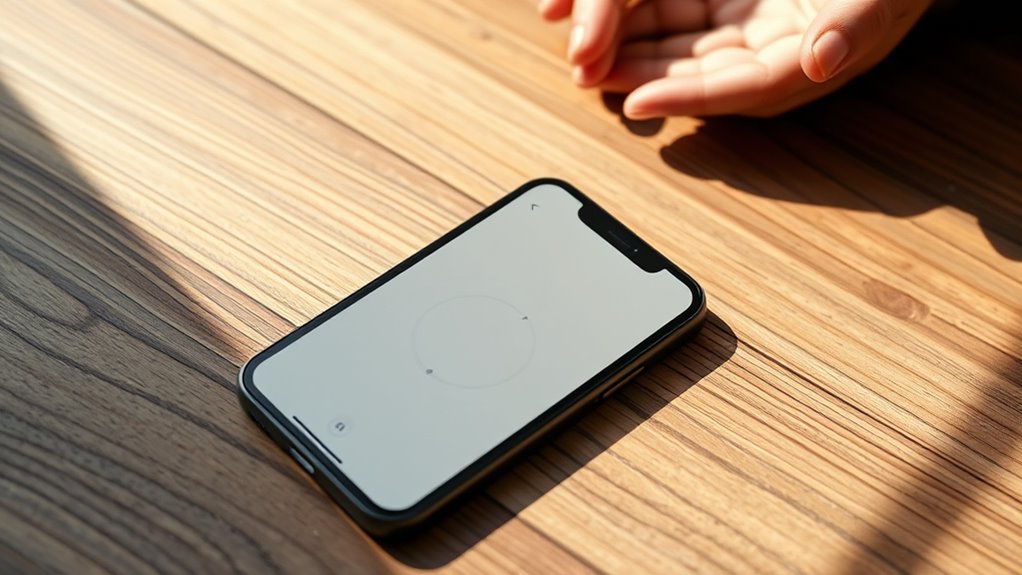
Designing breath-based meditation apps with engaging features can substantially boost user adherence and overall experience. A calming interface with soothing colors and rounded elements creates a relaxing environment that encourages regular use. Personalization options allow you to tailor sessions to your preferences, increasing satisfaction. Clear feedback mechanisms help you track progress and stay motivated. Incorporating multimedia like nature sounds or music enhances relaxation and immersion during practice. Effective design principles such as minimalism and consistency reduce distractions, making it easier to focus. Features like goal setting, reminders, and progress tracking support your consistency. Additionally, integrating sensor data and AI-generated insights offers personalized recommendations. Thoughtful visual and audio choices, including guided sessions and customizable soundscapes, further deepen engagement, making meditation more enjoyable and sustainable.
Future Directions and Research Gaps in Mobile Mindfulness Interventions
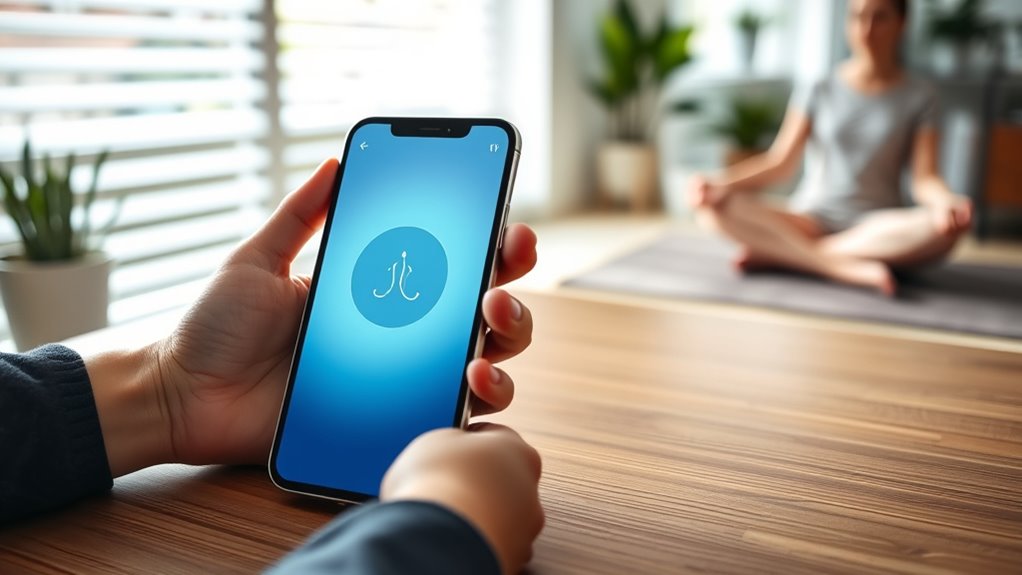
Future research in mobile mindfulness interventions must address several key gaps to enhance their effectiveness and reach. You’ll need larger sample sizes to improve the reliability of findings across diverse populations. Long-term studies are essential to understand sustainability and lasting benefits. Standardizing randomized controlled trial protocols can reduce variability in delivering interventions and measuring outcomes. Mechanistic studies should explore the neurobiological and behavioral pathways through which these apps work. Additionally, dose-response analyses can help identify the minimum effective duration. Expanding target populations—such as minorities, low-income groups, adolescents, and older adults—requires tailored content and accessibility adaptations. Improving outcome measurement through ecological assessments, biometric data, and cultural validation will enhance precision. Finally, technological advancements like AI personalization and immersive tech can optimize user engagement and efficacy.
Frequently Asked Questions
Can Breath-Based Meditation Apps Effectively Replace In-Person Mindfulness Training?
You might wonder if breath-based meditation apps can truly replace in-person training. While apps offer convenient access and help you develop mindfulness, they lack the personal interaction and tailored feedback you get from a trainer. Self-directed practices can be effective, but ongoing engagement and customization are limited. Ultimately, apps can supplement your practice but may not fully replicate the depth and connection of in-person mindfulness training.
What Are the Long-Term Benefits of Consistent App-Based Mindfulness Practice?
Thinking long-term about mindfulness apps? Well, if you keep practicing consistently, you’ll likely enjoy reduced depression and anxiety, better emotional regulation, and sharper focus. It’s like training your brain to be more resilient, happier, and less overwhelmed—without leaving your couch. These benefits stick around for months, helping you stay calm, clear-headed, and in control. So, yes, your phone might just become your best mental health investment.
Are There Specific Populations That Benefit More From Meditation Apps?
You’ll find that certain groups benefit more from meditation apps. If you have pre-existing anxiety or depression, you might notice more significant improvements because these apps offer targeted, evidence-based strategies. Younger adults tend to engage more due to familiarity with technology, while older adults can use them to manage stress or sleep issues. People with chronic health conditions also often see benefits, especially when traditional treatments are limited or inaccessible.
How Do App Features Influence User Engagement and Effectiveness?
You’ll find that app features greatly boost your engagement and effectiveness. Customizable session lengths and varied exercises keep your practice relevant, while adjustable sounds enhance comfort. Easy-to-use interfaces and progress tracking motivate you to stick with it. When apps offer diverse content and convenient mobile access, you’re more likely to practice regularly. These elements foster better mental health outcomes, making your meditation experience both enjoyable and impactful.
What Are the Best Practices for Integrating Meditation Apps Into Clinical Treatment?
Oh, sure, just toss a meditation app into therapy and hope for magic! But realistically, you should assess patient needs carefully, choose evidence-based apps, and personalize the introduction. Regular follow-ups, ongoing support, and feedback are crucial. Overcoming barriers like tech issues or motivation lapses ensures better outcomes. Remember, integrating apps thoughtfully with traditional therapy maximizes benefits, making the digital leap truly worthwhile and not just a passing trend.
Conclusion
Ultimately, embracing breath-based meditation apps can boost your balance, calm your cortisol, and cultivate calmness. By blending biology with technology, these tools bolster your well-being and ward off worry. While challenges exist, consistent practice can create a confident, calm, and centered you. So, seize the simplicity, savor the serenity, and let the soothing science of breath guide your journey to wellness. Your mindful moment awaits—make it meaningful today.
